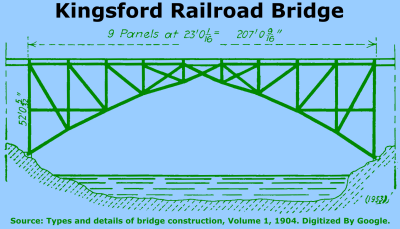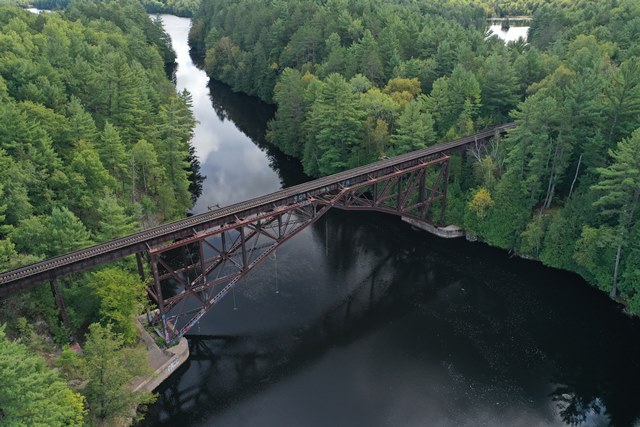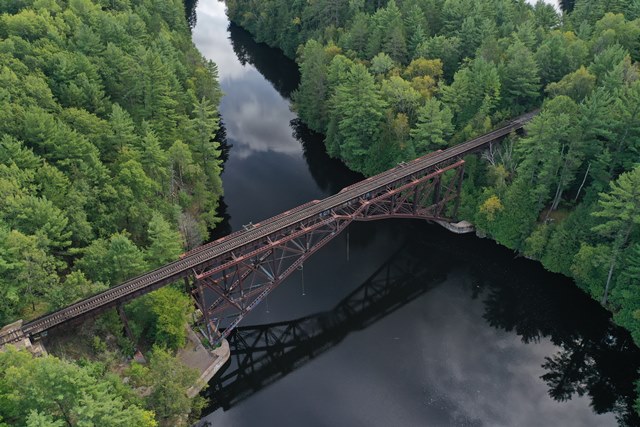We Recommend:
Bach Steel - Experts at historic truss bridge restoration.
Kingsford Railroad Bridge
Chicago, Milwaukee, and St. Paul Railroad Menominee River Bridge

Primary Photographer(s): Nathan Holth
Bridge Documented: October 1, 2012
Railroad (Escanaba and Lake Superior Railroad) Over Menominee River
Near Kingsford: Dickinson County, Michigan and Florence County, Wisconsin: United States
Metal 9 Panel Three-Hinged Solid Ribbed Spandrel Braced Deck Arch, Fixed and Approach Spans: Metal Deck Girder, Fixed
1902 By Builder/Contractor: Phoenix Bridge Company of Phoenixville, Pennsylvania and Engineer/Design: Charles Frederick Loweth
Not Available or Not Applicable
207.0 Feet (63.1 Meters)
357.0 Feet (108.8 Meters)
Not Available
1 Main Span(s) and 4 Approach Span(s)
Not Applicable

View Information About HSR Ratings
Bridge Documentation
The previous bridge at this location was moved to become part of the Dunnville Railroad Bridge.
View Historical Articles About This Historic Bridge
Above: Aerial view of bridge, September 10, 2020. Click for enlargement. Photo Credit: Doug Heim, Angelcopter, LLC
This steel bridge is one of the most unusual bridges ever to be encountered. It is an arch bridge that does not have a traditional arch shape. Rather than having a uniformly curved arch rib, or even an elliptically curved arch rib, the arch rib is not curved and is instead polygonal, with long straight sections that change angles at connection points. However, the most unusual detail is at the center two panels of the structure. At these panels, the top chord of the superstructure bends down sharply. At the same panels, the arch rib bends up. As a result, at these panels, the angle of the top chord lines up with the arch rib. The top chord and the arch rib meet together at the central crown hinge pin of the arch. The crown hinge pin is about six feet below the center of the horizontal portion of the top chord. Because of this bizarre detail, the bridge has the appearance of being pinched in the center, and has the appearance of being two halves. To a casual viewer, it might appear like a truss that is cantilevered out to the center. However, unlike a cantilevered truss, each half of this arch bridge requires the other half in order to stand. Despite the unusual shape that the arch rib follows, the bridge does function as a three hinged arch bridge. Further evidence of the arch function of the bridge is found at the abutments. The arch ribs terminate at hinges and skewbacks, rather than resting flat on a bearing as a truss bridge would do.
The aforementioned unusual detail at the center of this bridge was decided upon after consideration of other designs. The unusual design reduced the materials required for the bridge, while also avoiding unwanted stresses that were present in other designs.
In general, this unusual bridge appears to be a little known secret. It does appear that an arch bridge was chosen for this location because of the topography. The river here cuts a fairly steep and rocky gorge (on that makes photography of the bridge difficult for those without a boat). This topography lends itself well to the function of a steel deck arch bridge. The Historic American Engineering Record reported that the bridge is probably the second bridge at this location, since the Chicago, Milwaukee, and St. Paul Railroad reached Iron Mountain in 1886. A period article about the bridge stated that the previous bridge was a Pratt deck truss with a 225 foot span. A historical photo of the arch bridge under construction appears to show the previous bridge in the background as a double intersection Pratt (Whipple) deck truss. The arch bridge was built in 1902. It includes a series of approach spans. Each end has two 75 foot deck plate girder approach spans. The main span was listed in the Historic American Engineering Record as 180 feet (54.9 meters) long, and in period article about the bridge as 207 feet (63.1 meters). The bridge width center-to-center of the arches is 22 feet (6.7 meters). The abutments for the bridge are concrete. The approach spans also have steel bents for support, which in turn rest on concrete foundations.
A 1910 Handbook of Cost Data for Contractors and Engineers provided the following information:
A single track, three-hinged steel arch bridge was finished in 1903 across the Menominee River, Michigan, for the Chicago, Milwaukee & St. Paul Ry., replacing a steel bridge built 17 years previously, which had grown too light for the traffic. The bridge is 355 ft. long, consisting of a three-hinged arch of 207 ft. span and four plate girder approach spans of 39% ft. each. The trusses are 22 ft. c. to c. The arch has a rise of 52 ft. The bridge is designed according to Cooper's specifications for a live load of two consolidation Class E-50 locomotives and 7,000 lbs. per lin. ft. behind the engines. The weight of steel in the arch span is 480,000 lbs., and in the approach spans it is 150,000 lbs.
Above: Aerial view of bridge, September 10, 2020. Click for enlargement. Photo Credit: Doug Heim, Angelcopter, LLC
Above: Aerial view of bridge, September 10, 2020. Click for enlargement. Photo Credit: Doug Heim, Angelcopter, LLC
![]()
Photo Galleries and Videos: Kingsford Railroad Bridge
Bridge Photo-Documentation
Original / Full Size PhotosA collection of overview and detail photos. This gallery offers photos in the highest available resolution and file size in a touch-friendly popup viewer.
Alternatively, Browse Without Using Viewer
![]()
Bridge Photo-Documentation
Mobile Optimized PhotosA collection of overview and detail photos. This gallery features data-friendly, fast-loading photos in a touch-friendly popup viewer.
Alternatively, Browse Without Using Viewer
![]()
Drone Footage, Courtesy Doug Heim, Angelcopter, LLC
Full Motion VideoNote: The downloadable high quality version of this video (available on the video page) is well worth the download since it offers excellent 1080 HD detail and is vastly more impressive than the compressed streaming video. Streaming video of the bridge. Also includes a higher quality downloadable video for greater clarity or offline viewing.
![]()
Maps and Links: Kingsford Railroad Bridge
Coordinates (Latitude, Longitude):
Search For Additional Bridge Listings:
Bridgehunter.com: View listed bridges within 0.5 miles (0.8 kilometers) of this bridge.
Bridgehunter.com: View listed bridges within 10 miles (16 kilometers) of this bridge.
Additional Maps:
Google Streetview (If Available)
GeoHack (Additional Links and Coordinates)
Apple Maps (Via DuckDuckGo Search)
Apple Maps (Apple devices only)
Android: Open Location In Your Map or GPS App
Flickr Gallery (Find Nearby Photos)
Wikimedia Commons (Find Nearby Photos)
Directions Via Sygic For Android
Directions Via Sygic For iOS and Android Dolphin Browser
USGS National Map (United States Only)
Historical USGS Topo Maps (United States Only)
Historic Aerials (United States Only)
CalTopo Maps (United States Only)








